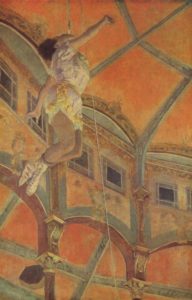Edgar Degas (1834-1917) if often referred to as an impressionist. His choice of themes certainly agrees with this observation; he portrays people from dance halls, cafés, concerts, theater. Life on stage is often reflected in his work, but not only its glamorous side. He liked to describe himself as “realist”–a painter whose art reveals the true nature of his objects, not just the impressions they create. Originally, he wanted to be a history painter, but he later decided to dedicate his creative faculties to portraying the modernist spirit in an urban setting.
Unlike other Impressionists, Degas ascribed much importance to composition. Boldly calculated, his characters–mostly women–are depicted from unique angles, with special reflections of light. As part of his attempt to capture modernism, his characters reveal his observations on the relationships between life on and off stage.
Miss La La at the Cirque Fernando, created in 1879, depicts a real-life acrobat, Miss La La, performing at the Fernando Circus in Paris. She was slowly suspended 70 feet high in the air from the rafter of the circus dome by a rope clenched between her teeth. Degas was captivated by this performance. For eight consecutive nights, he went to the circus, painting her from different directions (the Tate Gallery has a painting from this series from another angle) until he felt the result fully grasped the essence of her show.
I find the depiction of Miss La La essentially different from his many paintings of women and the female body. His portrayals of various dancers and women in the toilettes have a pronounced aesthetic quality, pleasant to a layman’s eyes. Not so Miss La La. Though a female performer, she almost lacks the sex appeal so typical of his female characters. She is an abstraction of the woman performer, an emblem of show business in its most simple and unsophisticated form: the circus. A closer examination of this painting reveals Degas’s profound insights into certain aspects of popular show business in the modern age, which prevails in TV shows today.
The strange angle: The most prominent feature of Miss La La is the angle from which we see her. The spectators are underneath her, looking up, without even seeing her face. This striking perspective is intriguing, and we know Degas planned the composition meticulously, saying “no art was ever less spontaneous than mine.” This painting portrays the show as fantastic, spectacular, utterly remote from real life. The spectators can’t see the face of the performer, but it doesn’t matter. They are not looking for insights into human nature or profound observations on the human condition; they want highly exciting entertainment, a woman clinging to a rope with her teeth, dangling high in the air. Aristotle named “the spectacle” (opsis) as one of six elements of a theatrical performance but felt it was the most superficial one; “spectacle has, indeed, an emotional attraction of its own, but, of all the parts, it is the least artistic, and connected least with the art of poetry.”
A faceless acrobat: The heart of this performance is Miss La La’s biting the rope with her teeth, yet we can’t see this in the painting. The spectators need to know that the artist is doing something extremely difficult, but they don’t want to actually see the exertion. They want the performer to surmount physical or emotional obstacles, perhaps overcome personal misfortune or a tragic life story, but they have no desire to witness the disappointments, pain, heartbreak, and humiliations. This combination of unseen effort and astounding performance deepens the psychological effect of the show, because it adds a taste of triumph, a feeling of having witnessed some sort of victory. Miss La La’s body floating in the air is light and graceful, revealing nothing of her physical and psychological strain.
The risk: Circus performance involves a special risk; it is part of their appeal. We know Miss La La was hanging high in the circus dome without any safety measures to save her if she were to fall. Contemporary entertainment shows don’t carry the physical risk anymore, but if you think about such reality shows as Big Brother, American Idol, The Voice, and X Factor, the contestants take the risk of being publicly humiliated, in some cases, and expelled from the show. It may be the case that the audience feels more satisfied, or even aggrandized, knowing that performers are willing to cope with difficult challenges in order to perform on stage.
The black performer: Miss La La is, I think, the only Black woman Degas ever painted. Because he was a profound conservative opposing any social reform (and also an anti-Semite), a black performer must have seemed slightly bizarre to him, perhaps even freakish. From this twisted and racist point of view, portraying Miss La La may refer to a certain tendency to look for unusual performers with abnormal characteristics. TV shows actively seek participants with some sort of bizarre feature and, even “ordinary” participants are often asked to reveal something embarrassing or kinky about themselves.This is not typical only of modern entertainment. The human tendency to peek at bizarre, strange, and sometimes sick people is as old as humanity. Masks of ancient Greek theater represented some abnormal characters; the commedia dell’arte, the first professional theater from the sixteenth century, had some bizarre-looking performers; Victor Hugo depicted The Hunchback of Notre-Dame; and modern films often portray people of “abnormal” body or mind (e.g. Rain Man, Mask). Modern show business, both live and recorded, enhance this inclination since the spectators can see the strange and bizarre in greater detail.
Now take a look at Susan Boyle’s audition for American Idol – didn’t Degas foresee exactly this kind of entertainment?


Thanks! 🙂
Enjoyable survey, very perceptive. Plus, I’ve learned a few new facts about Degas. Many thanks Emanuela, best day wishes… 😊